Analyzing Telstra's Organizational Change and Stakeholder Impact
VerifiedAdded on 2022/11/03
|19
|4745
|331
Report
AI Summary
This report provides an in-depth analysis of Telstra's organizational change initiative, examining its restructuring efforts aimed at improving customer experience, simplifying its structure, and reducing costs. The report explores the engagement of key stakeholders, including customers, management, investors, and business partners, and assesses the consequences of the changes on each group. It delves into the communication strategies employed by Telstra, highlighting the use of situational leadership and the application of the McKinsey 7S model. Furthermore, the report identifies areas where the change implementation could have been improved, such as communication timing and the style of implementation. It concludes with recommendations for future change projects, emphasizing the importance of enhanced communication and strategic planning to mitigate resistance and ensure successful outcomes. The report also analyzes a change project that the student has experienced by taking customer service as an example of organizational change.
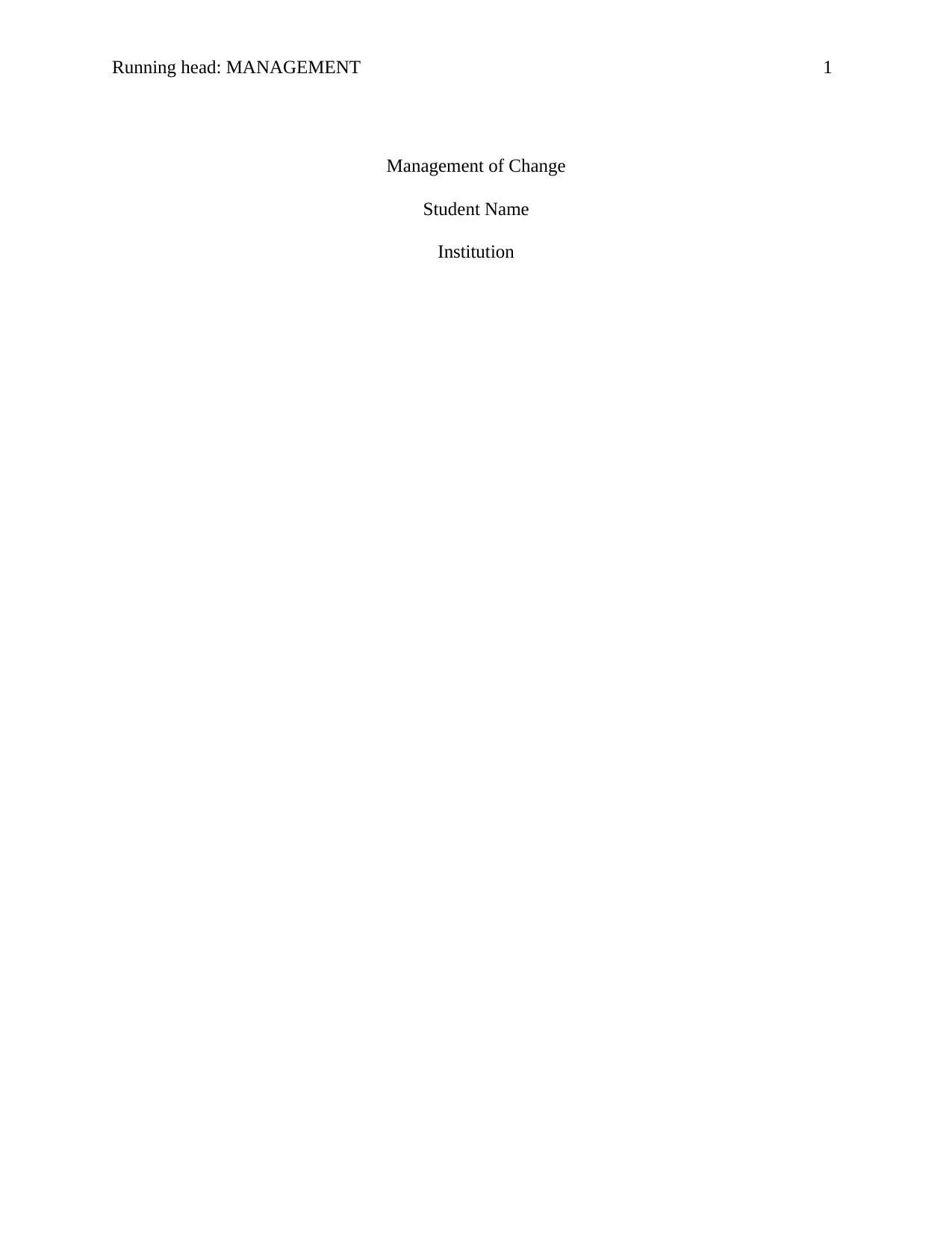
Running head: MANAGEMENT 1
Management of Change
Student Name
Institution
Management of Change
Student Name
Institution
Paraphrase This Document
Need a fresh take? Get an instant paraphrase of this document with our AI Paraphraser
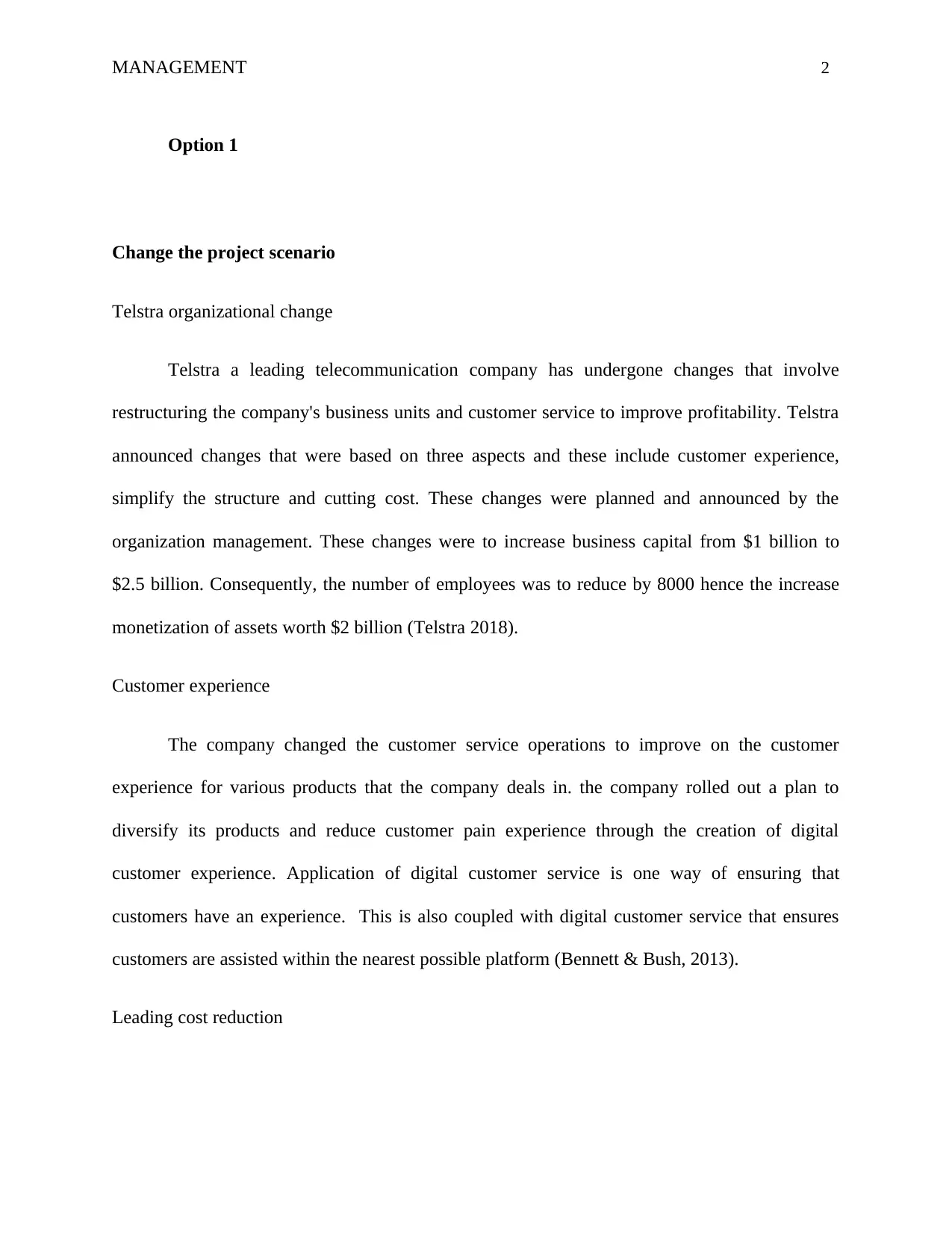
MANAGEMENT 2
Option 1
Change the project scenario
Telstra organizational change
Telstra a leading telecommunication company has undergone changes that involve
restructuring the company's business units and customer service to improve profitability. Telstra
announced changes that were based on three aspects and these include customer experience,
simplify the structure and cutting cost. These changes were planned and announced by the
organization management. These changes were to increase business capital from $1 billion to
$2.5 billion. Consequently, the number of employees was to reduce by 8000 hence the increase
monetization of assets worth $2 billion (Telstra 2018).
Customer experience
The company changed the customer service operations to improve on the customer
experience for various products that the company deals in. the company rolled out a plan to
diversify its products and reduce customer pain experience through the creation of digital
customer experience. Application of digital customer service is one way of ensuring that
customers have an experience. This is also coupled with digital customer service that ensures
customers are assisted within the nearest possible platform (Bennett & Bush, 2013).
Leading cost reduction
Option 1
Change the project scenario
Telstra organizational change
Telstra a leading telecommunication company has undergone changes that involve
restructuring the company's business units and customer service to improve profitability. Telstra
announced changes that were based on three aspects and these include customer experience,
simplify the structure and cutting cost. These changes were planned and announced by the
organization management. These changes were to increase business capital from $1 billion to
$2.5 billion. Consequently, the number of employees was to reduce by 8000 hence the increase
monetization of assets worth $2 billion (Telstra 2018).
Customer experience
The company changed the customer service operations to improve on the customer
experience for various products that the company deals in. the company rolled out a plan to
diversify its products and reduce customer pain experience through the creation of digital
customer experience. Application of digital customer service is one way of ensuring that
customers have an experience. This is also coupled with digital customer service that ensures
customers are assisted within the nearest possible platform (Bennett & Bush, 2013).
Leading cost reduction
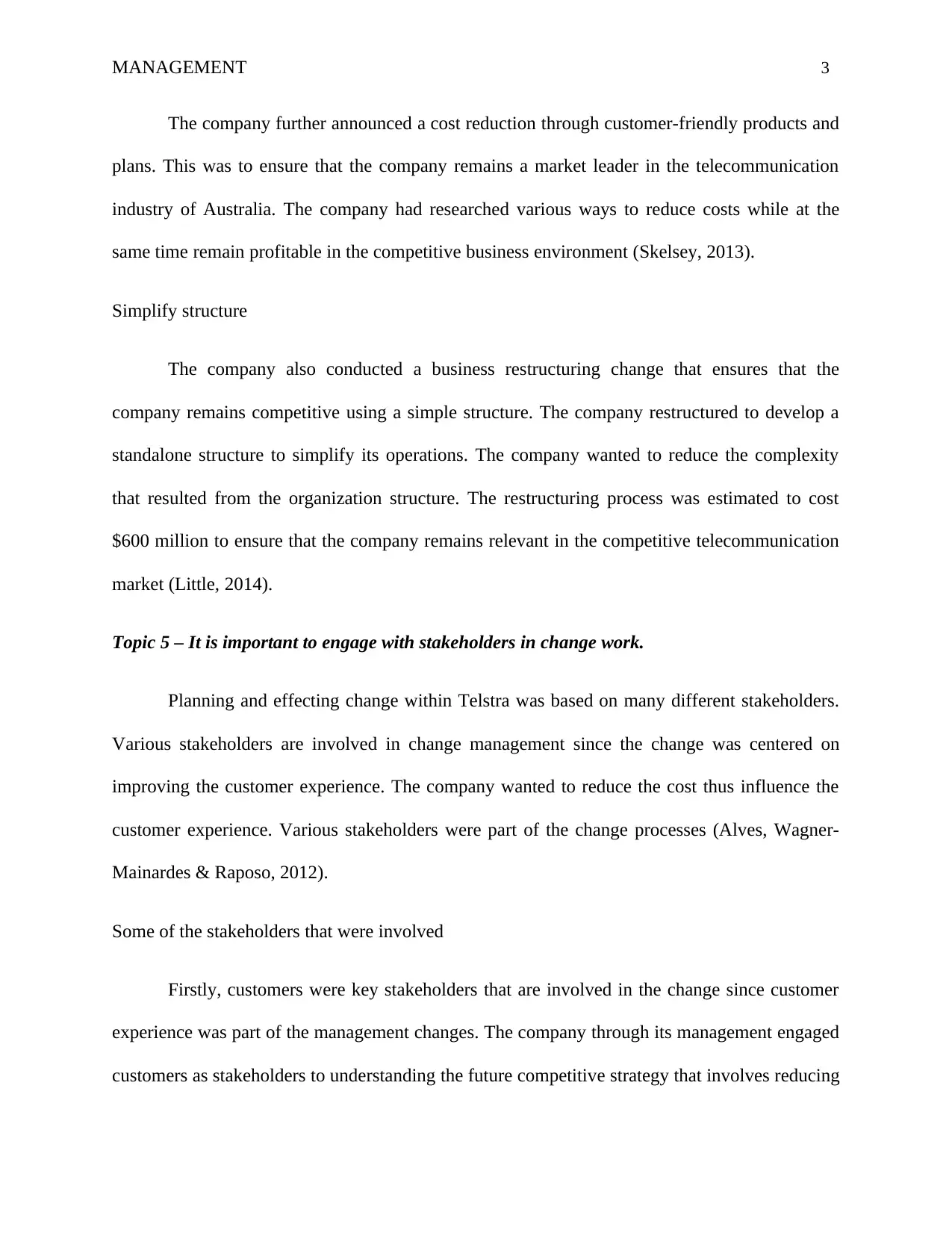
MANAGEMENT 3
The company further announced a cost reduction through customer-friendly products and
plans. This was to ensure that the company remains a market leader in the telecommunication
industry of Australia. The company had researched various ways to reduce costs while at the
same time remain profitable in the competitive business environment (Skelsey, 2013).
Simplify structure
The company also conducted a business restructuring change that ensures that the
company remains competitive using a simple structure. The company restructured to develop a
standalone structure to simplify its operations. The company wanted to reduce the complexity
that resulted from the organization structure. The restructuring process was estimated to cost
$600 million to ensure that the company remains relevant in the competitive telecommunication
market (Little, 2014).
Topic 5 – It is important to engage with stakeholders in change work.
Planning and effecting change within Telstra was based on many different stakeholders.
Various stakeholders are involved in change management since the change was centered on
improving the customer experience. The company wanted to reduce the cost thus influence the
customer experience. Various stakeholders were part of the change processes (Alves, Wagner-
Mainardes & Raposo, 2012).
Some of the stakeholders that were involved
Firstly, customers were key stakeholders that are involved in the change since customer
experience was part of the management changes. The company through its management engaged
customers as stakeholders to understanding the future competitive strategy that involves reducing
The company further announced a cost reduction through customer-friendly products and
plans. This was to ensure that the company remains a market leader in the telecommunication
industry of Australia. The company had researched various ways to reduce costs while at the
same time remain profitable in the competitive business environment (Skelsey, 2013).
Simplify structure
The company also conducted a business restructuring change that ensures that the
company remains competitive using a simple structure. The company restructured to develop a
standalone structure to simplify its operations. The company wanted to reduce the complexity
that resulted from the organization structure. The restructuring process was estimated to cost
$600 million to ensure that the company remains relevant in the competitive telecommunication
market (Little, 2014).
Topic 5 – It is important to engage with stakeholders in change work.
Planning and effecting change within Telstra was based on many different stakeholders.
Various stakeholders are involved in change management since the change was centered on
improving the customer experience. The company wanted to reduce the cost thus influence the
customer experience. Various stakeholders were part of the change processes (Alves, Wagner-
Mainardes & Raposo, 2012).
Some of the stakeholders that were involved
Firstly, customers were key stakeholders that are involved in the change since customer
experience was part of the management changes. The company through its management engaged
customers as stakeholders to understanding the future competitive strategy that involves reducing
⊘ This is a preview!⊘
Do you want full access?
Subscribe today to unlock all pages.

Trusted by 1+ million students worldwide
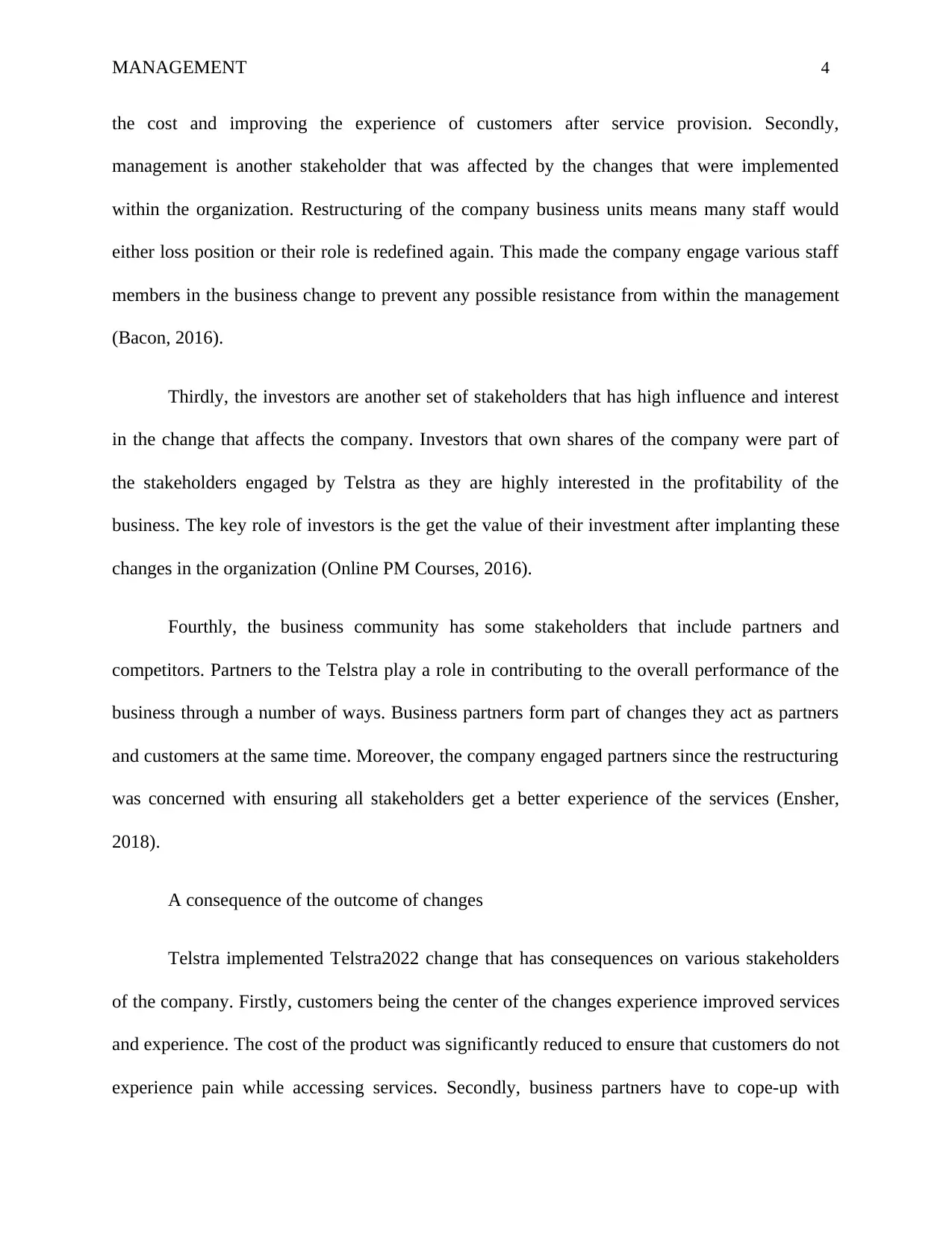
MANAGEMENT 4
the cost and improving the experience of customers after service provision. Secondly,
management is another stakeholder that was affected by the changes that were implemented
within the organization. Restructuring of the company business units means many staff would
either loss position or their role is redefined again. This made the company engage various staff
members in the business change to prevent any possible resistance from within the management
(Bacon, 2016).
Thirdly, the investors are another set of stakeholders that has high influence and interest
in the change that affects the company. Investors that own shares of the company were part of
the stakeholders engaged by Telstra as they are highly interested in the profitability of the
business. The key role of investors is the get the value of their investment after implanting these
changes in the organization (Online PM Courses, 2016).
Fourthly, the business community has some stakeholders that include partners and
competitors. Partners to the Telstra play a role in contributing to the overall performance of the
business through a number of ways. Business partners form part of changes they act as partners
and customers at the same time. Moreover, the company engaged partners since the restructuring
was concerned with ensuring all stakeholders get a better experience of the services (Ensher,
2018).
A consequence of the outcome of changes
Telstra implemented Telstra2022 change that has consequences on various stakeholders
of the company. Firstly, customers being the center of the changes experience improved services
and experience. The cost of the product was significantly reduced to ensure that customers do not
experience pain while accessing services. Secondly, business partners have to cope-up with
the cost and improving the experience of customers after service provision. Secondly,
management is another stakeholder that was affected by the changes that were implemented
within the organization. Restructuring of the company business units means many staff would
either loss position or their role is redefined again. This made the company engage various staff
members in the business change to prevent any possible resistance from within the management
(Bacon, 2016).
Thirdly, the investors are another set of stakeholders that has high influence and interest
in the change that affects the company. Investors that own shares of the company were part of
the stakeholders engaged by Telstra as they are highly interested in the profitability of the
business. The key role of investors is the get the value of their investment after implanting these
changes in the organization (Online PM Courses, 2016).
Fourthly, the business community has some stakeholders that include partners and
competitors. Partners to the Telstra play a role in contributing to the overall performance of the
business through a number of ways. Business partners form part of changes they act as partners
and customers at the same time. Moreover, the company engaged partners since the restructuring
was concerned with ensuring all stakeholders get a better experience of the services (Ensher,
2018).
A consequence of the outcome of changes
Telstra implemented Telstra2022 change that has consequences on various stakeholders
of the company. Firstly, customers being the center of the changes experience improved services
and experience. The cost of the product was significantly reduced to ensure that customers do not
experience pain while accessing services. Secondly, business partners have to cope-up with
Paraphrase This Document
Need a fresh take? Get an instant paraphrase of this document with our AI Paraphraser
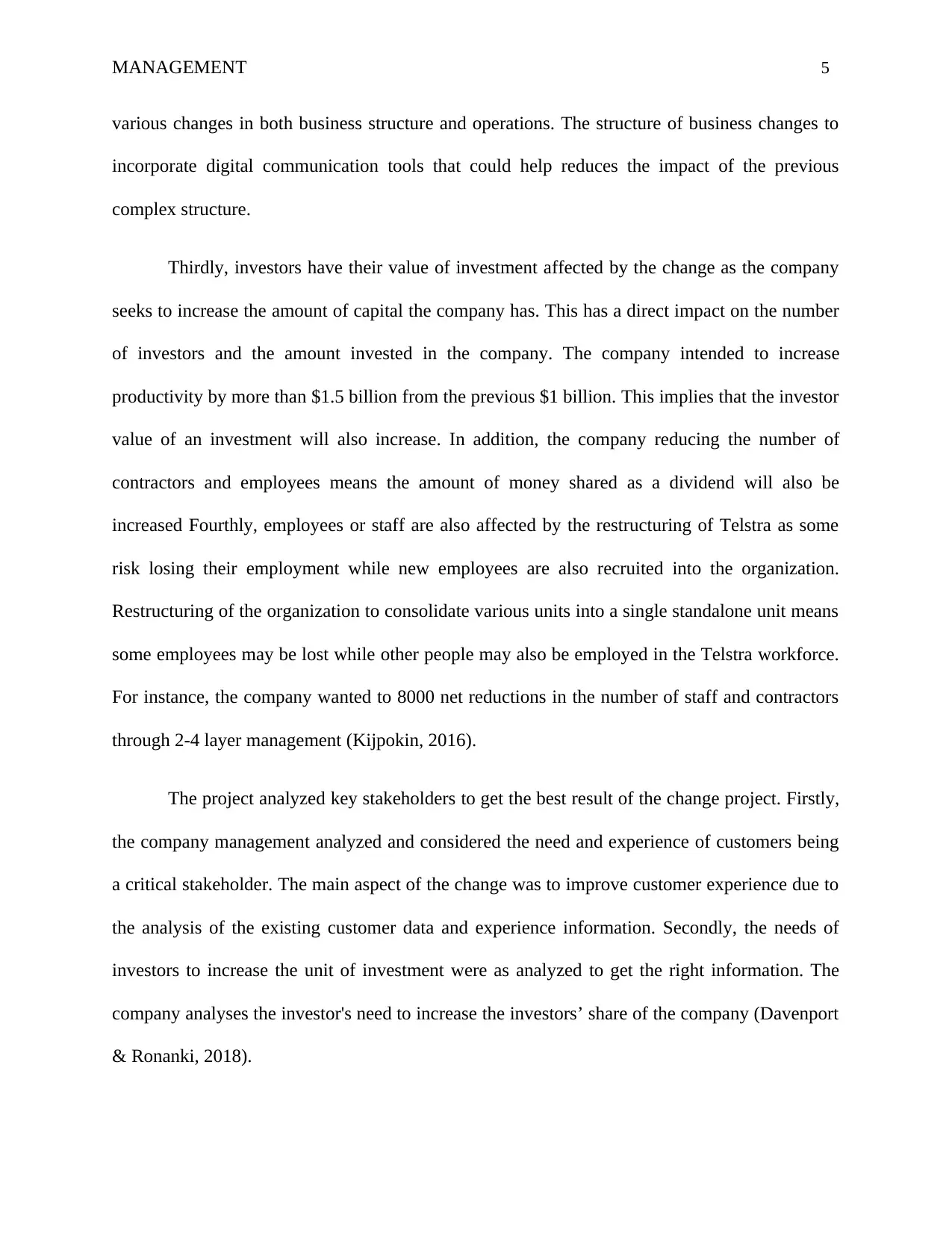
MANAGEMENT 5
various changes in both business structure and operations. The structure of business changes to
incorporate digital communication tools that could help reduces the impact of the previous
complex structure.
Thirdly, investors have their value of investment affected by the change as the company
seeks to increase the amount of capital the company has. This has a direct impact on the number
of investors and the amount invested in the company. The company intended to increase
productivity by more than $1.5 billion from the previous $1 billion. This implies that the investor
value of an investment will also increase. In addition, the company reducing the number of
contractors and employees means the amount of money shared as a dividend will also be
increased Fourthly, employees or staff are also affected by the restructuring of Telstra as some
risk losing their employment while new employees are also recruited into the organization.
Restructuring of the organization to consolidate various units into a single standalone unit means
some employees may be lost while other people may also be employed in the Telstra workforce.
For instance, the company wanted to 8000 net reductions in the number of staff and contractors
through 2-4 layer management (Kijpokin, 2016).
The project analyzed key stakeholders to get the best result of the change project. Firstly,
the company management analyzed and considered the need and experience of customers being
a critical stakeholder. The main aspect of the change was to improve customer experience due to
the analysis of the existing customer data and experience information. Secondly, the needs of
investors to increase the unit of investment were as analyzed to get the right information. The
company analyses the investor's need to increase the investors’ share of the company (Davenport
& Ronanki, 2018).
various changes in both business structure and operations. The structure of business changes to
incorporate digital communication tools that could help reduces the impact of the previous
complex structure.
Thirdly, investors have their value of investment affected by the change as the company
seeks to increase the amount of capital the company has. This has a direct impact on the number
of investors and the amount invested in the company. The company intended to increase
productivity by more than $1.5 billion from the previous $1 billion. This implies that the investor
value of an investment will also increase. In addition, the company reducing the number of
contractors and employees means the amount of money shared as a dividend will also be
increased Fourthly, employees or staff are also affected by the restructuring of Telstra as some
risk losing their employment while new employees are also recruited into the organization.
Restructuring of the organization to consolidate various units into a single standalone unit means
some employees may be lost while other people may also be employed in the Telstra workforce.
For instance, the company wanted to 8000 net reductions in the number of staff and contractors
through 2-4 layer management (Kijpokin, 2016).
The project analyzed key stakeholders to get the best result of the change project. Firstly,
the company management analyzed and considered the need and experience of customers being
a critical stakeholder. The main aspect of the change was to improve customer experience due to
the analysis of the existing customer data and experience information. Secondly, the needs of
investors to increase the unit of investment were as analyzed to get the right information. The
company analyses the investor's need to increase the investors’ share of the company (Davenport
& Ronanki, 2018).
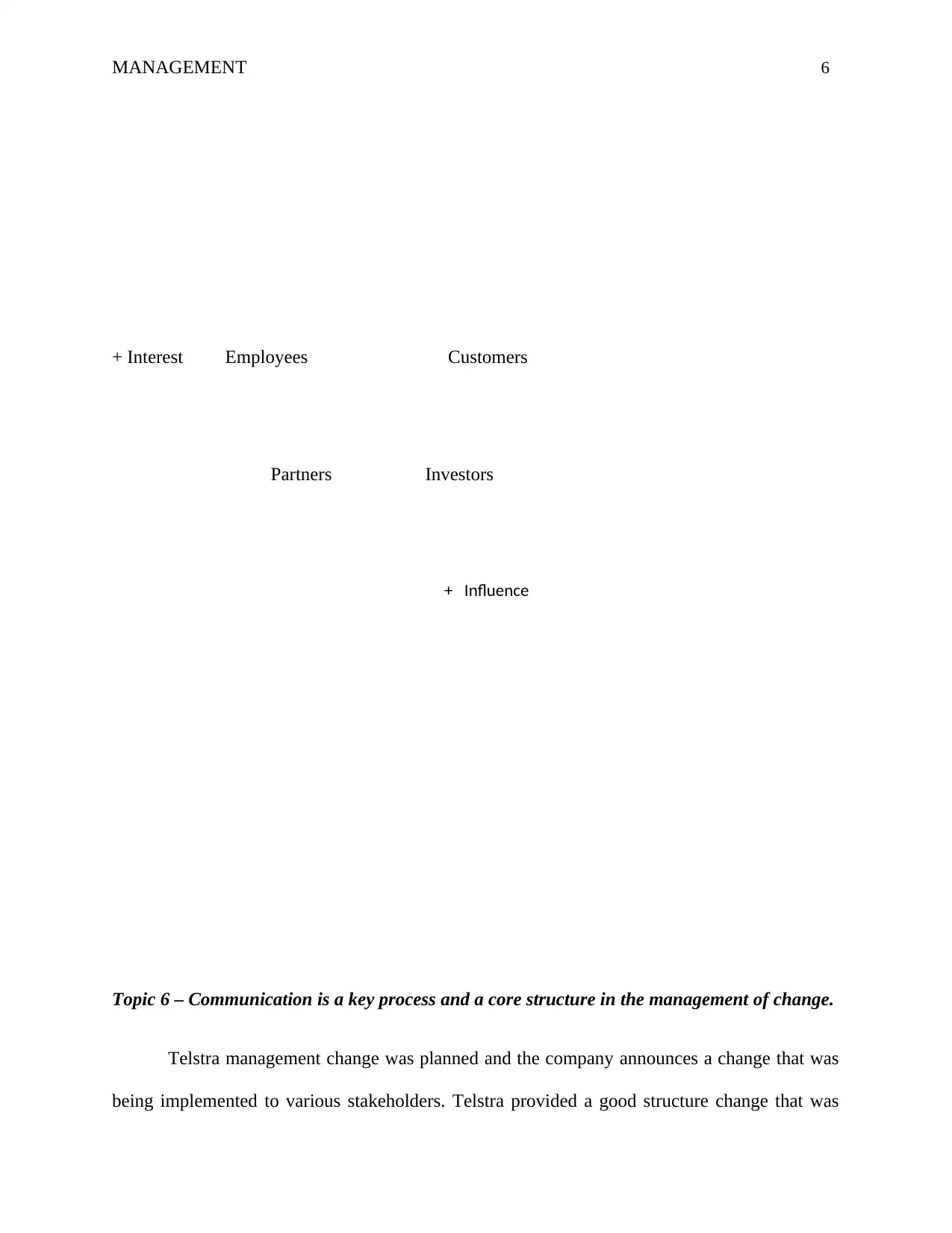
MANAGEMENT 6
+ Interest Employees Customers
Partners Investors
+ Influence
Topic 6 – Communication is a key process and a core structure in the management of change.
Telstra management change was planned and the company announces a change that was
being implemented to various stakeholders. Telstra provided a good structure change that was
+ Interest Employees Customers
Partners Investors
+ Influence
Topic 6 – Communication is a key process and a core structure in the management of change.
Telstra management change was planned and the company announces a change that was
being implemented to various stakeholders. Telstra provided a good structure change that was
⊘ This is a preview!⊘
Do you want full access?
Subscribe today to unlock all pages.

Trusted by 1+ million students worldwide
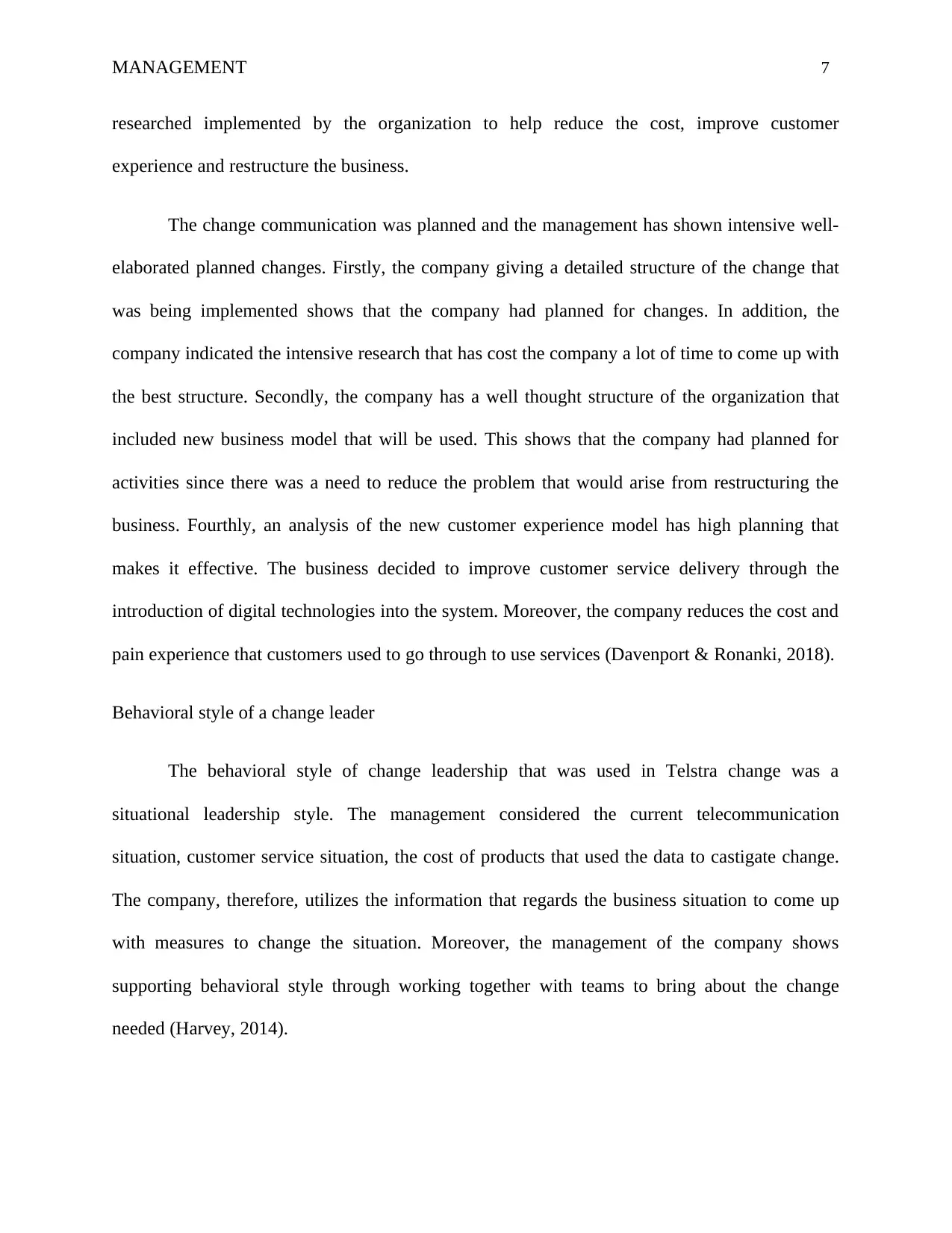
MANAGEMENT 7
researched implemented by the organization to help reduce the cost, improve customer
experience and restructure the business.
The change communication was planned and the management has shown intensive well-
elaborated planned changes. Firstly, the company giving a detailed structure of the change that
was being implemented shows that the company had planned for changes. In addition, the
company indicated the intensive research that has cost the company a lot of time to come up with
the best structure. Secondly, the company has a well thought structure of the organization that
included new business model that will be used. This shows that the company had planned for
activities since there was a need to reduce the problem that would arise from restructuring the
business. Fourthly, an analysis of the new customer experience model has high planning that
makes it effective. The business decided to improve customer service delivery through the
introduction of digital technologies into the system. Moreover, the company reduces the cost and
pain experience that customers used to go through to use services (Davenport & Ronanki, 2018).
Behavioral style of a change leader
The behavioral style of change leadership that was used in Telstra change was a
situational leadership style. The management considered the current telecommunication
situation, customer service situation, the cost of products that used the data to castigate change.
The company, therefore, utilizes the information that regards the business situation to come up
with measures to change the situation. Moreover, the management of the company shows
supporting behavioral style through working together with teams to bring about the change
needed (Harvey, 2014).
researched implemented by the organization to help reduce the cost, improve customer
experience and restructure the business.
The change communication was planned and the management has shown intensive well-
elaborated planned changes. Firstly, the company giving a detailed structure of the change that
was being implemented shows that the company had planned for changes. In addition, the
company indicated the intensive research that has cost the company a lot of time to come up with
the best structure. Secondly, the company has a well thought structure of the organization that
included new business model that will be used. This shows that the company had planned for
activities since there was a need to reduce the problem that would arise from restructuring the
business. Fourthly, an analysis of the new customer experience model has high planning that
makes it effective. The business decided to improve customer service delivery through the
introduction of digital technologies into the system. Moreover, the company reduces the cost and
pain experience that customers used to go through to use services (Davenport & Ronanki, 2018).
Behavioral style of a change leader
The behavioral style of change leadership that was used in Telstra change was a
situational leadership style. The management considered the current telecommunication
situation, customer service situation, the cost of products that used the data to castigate change.
The company, therefore, utilizes the information that regards the business situation to come up
with measures to change the situation. Moreover, the management of the company shows
supporting behavioral style through working together with teams to bring about the change
needed (Harvey, 2014).
Paraphrase This Document
Need a fresh take? Get an instant paraphrase of this document with our AI Paraphraser
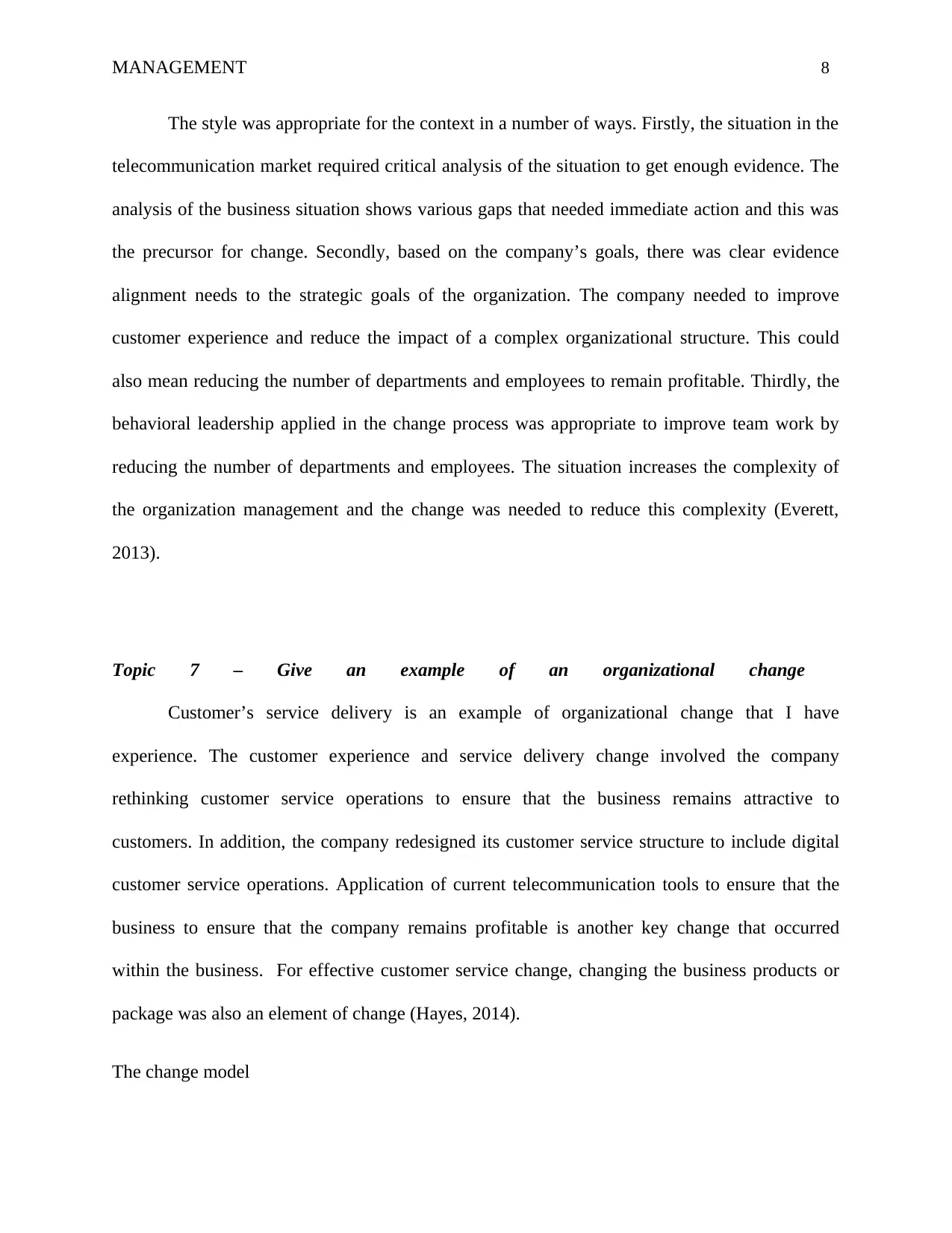
MANAGEMENT 8
The style was appropriate for the context in a number of ways. Firstly, the situation in the
telecommunication market required critical analysis of the situation to get enough evidence. The
analysis of the business situation shows various gaps that needed immediate action and this was
the precursor for change. Secondly, based on the company’s goals, there was clear evidence
alignment needs to the strategic goals of the organization. The company needed to improve
customer experience and reduce the impact of a complex organizational structure. This could
also mean reducing the number of departments and employees to remain profitable. Thirdly, the
behavioral leadership applied in the change process was appropriate to improve team work by
reducing the number of departments and employees. The situation increases the complexity of
the organization management and the change was needed to reduce this complexity (Everett,
2013).
Topic 7 – Give an example of an organizational change
Customer’s service delivery is an example of organizational change that I have
experience. The customer experience and service delivery change involved the company
rethinking customer service operations to ensure that the business remains attractive to
customers. In addition, the company redesigned its customer service structure to include digital
customer service operations. Application of current telecommunication tools to ensure that the
business to ensure that the company remains profitable is another key change that occurred
within the business. For effective customer service change, changing the business products or
package was also an element of change (Hayes, 2014).
The change model
The style was appropriate for the context in a number of ways. Firstly, the situation in the
telecommunication market required critical analysis of the situation to get enough evidence. The
analysis of the business situation shows various gaps that needed immediate action and this was
the precursor for change. Secondly, based on the company’s goals, there was clear evidence
alignment needs to the strategic goals of the organization. The company needed to improve
customer experience and reduce the impact of a complex organizational structure. This could
also mean reducing the number of departments and employees to remain profitable. Thirdly, the
behavioral leadership applied in the change process was appropriate to improve team work by
reducing the number of departments and employees. The situation increases the complexity of
the organization management and the change was needed to reduce this complexity (Everett,
2013).
Topic 7 – Give an example of an organizational change
Customer’s service delivery is an example of organizational change that I have
experience. The customer experience and service delivery change involved the company
rethinking customer service operations to ensure that the business remains attractive to
customers. In addition, the company redesigned its customer service structure to include digital
customer service operations. Application of current telecommunication tools to ensure that the
business to ensure that the company remains profitable is another key change that occurred
within the business. For effective customer service change, changing the business products or
package was also an element of change (Hayes, 2014).
The change model
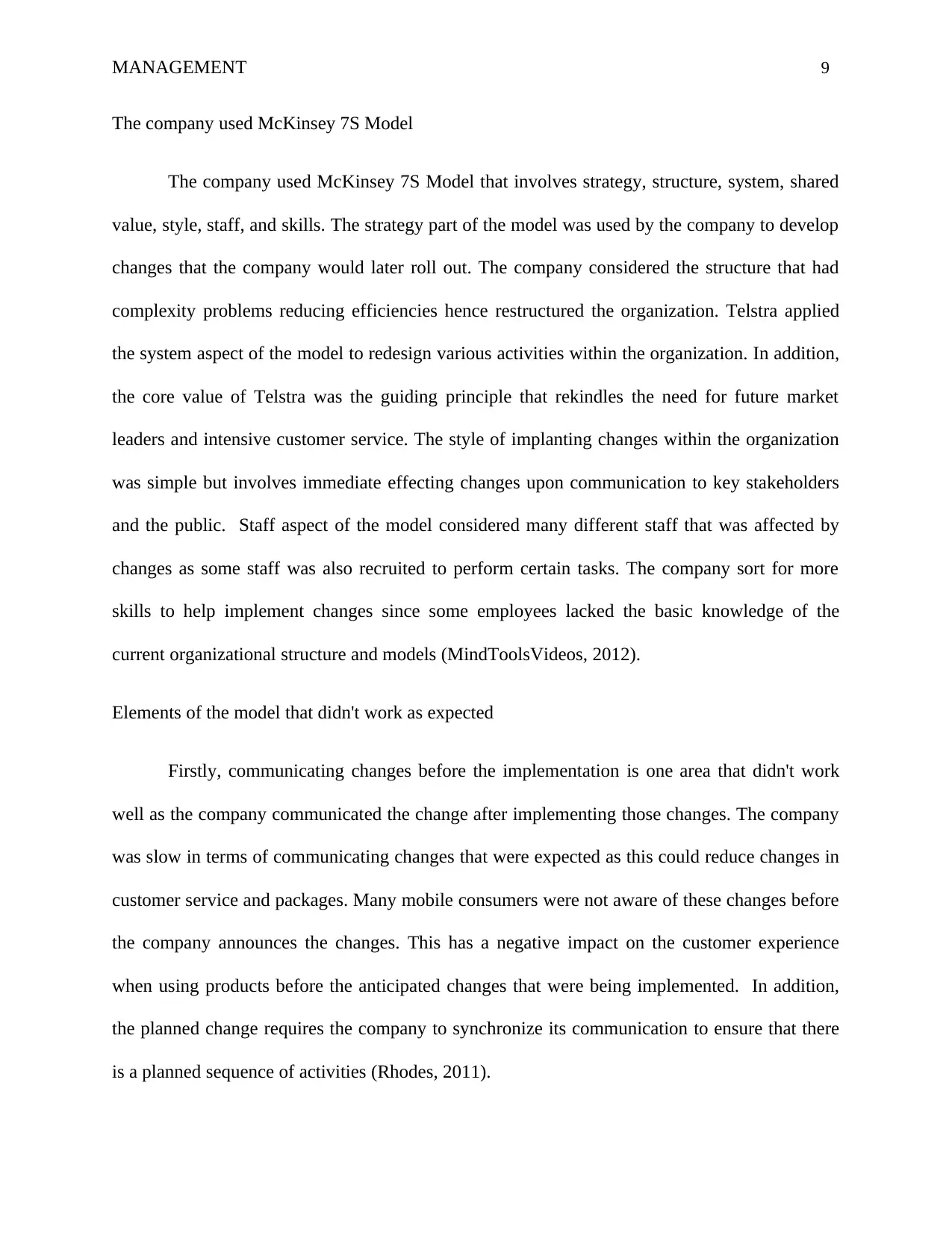
MANAGEMENT 9
The company used McKinsey 7S Model
The company used McKinsey 7S Model that involves strategy, structure, system, shared
value, style, staff, and skills. The strategy part of the model was used by the company to develop
changes that the company would later roll out. The company considered the structure that had
complexity problems reducing efficiencies hence restructured the organization. Telstra applied
the system aspect of the model to redesign various activities within the organization. In addition,
the core value of Telstra was the guiding principle that rekindles the need for future market
leaders and intensive customer service. The style of implanting changes within the organization
was simple but involves immediate effecting changes upon communication to key stakeholders
and the public. Staff aspect of the model considered many different staff that was affected by
changes as some staff was also recruited to perform certain tasks. The company sort for more
skills to help implement changes since some employees lacked the basic knowledge of the
current organizational structure and models (MindToolsVideos, 2012).
Elements of the model that didn't work as expected
Firstly, communicating changes before the implementation is one area that didn't work
well as the company communicated the change after implementing those changes. The company
was slow in terms of communicating changes that were expected as this could reduce changes in
customer service and packages. Many mobile consumers were not aware of these changes before
the company announces the changes. This has a negative impact on the customer experience
when using products before the anticipated changes that were being implemented. In addition,
the planned change requires the company to synchronize its communication to ensure that there
is a planned sequence of activities (Rhodes, 2011).
The company used McKinsey 7S Model
The company used McKinsey 7S Model that involves strategy, structure, system, shared
value, style, staff, and skills. The strategy part of the model was used by the company to develop
changes that the company would later roll out. The company considered the structure that had
complexity problems reducing efficiencies hence restructured the organization. Telstra applied
the system aspect of the model to redesign various activities within the organization. In addition,
the core value of Telstra was the guiding principle that rekindles the need for future market
leaders and intensive customer service. The style of implanting changes within the organization
was simple but involves immediate effecting changes upon communication to key stakeholders
and the public. Staff aspect of the model considered many different staff that was affected by
changes as some staff was also recruited to perform certain tasks. The company sort for more
skills to help implement changes since some employees lacked the basic knowledge of the
current organizational structure and models (MindToolsVideos, 2012).
Elements of the model that didn't work as expected
Firstly, communicating changes before the implementation is one area that didn't work
well as the company communicated the change after implementing those changes. The company
was slow in terms of communicating changes that were expected as this could reduce changes in
customer service and packages. Many mobile consumers were not aware of these changes before
the company announces the changes. This has a negative impact on the customer experience
when using products before the anticipated changes that were being implemented. In addition,
the planned change requires the company to synchronize its communication to ensure that there
is a planned sequence of activities (Rhodes, 2011).
⊘ This is a preview!⊘
Do you want full access?
Subscribe today to unlock all pages.

Trusted by 1+ million students worldwide
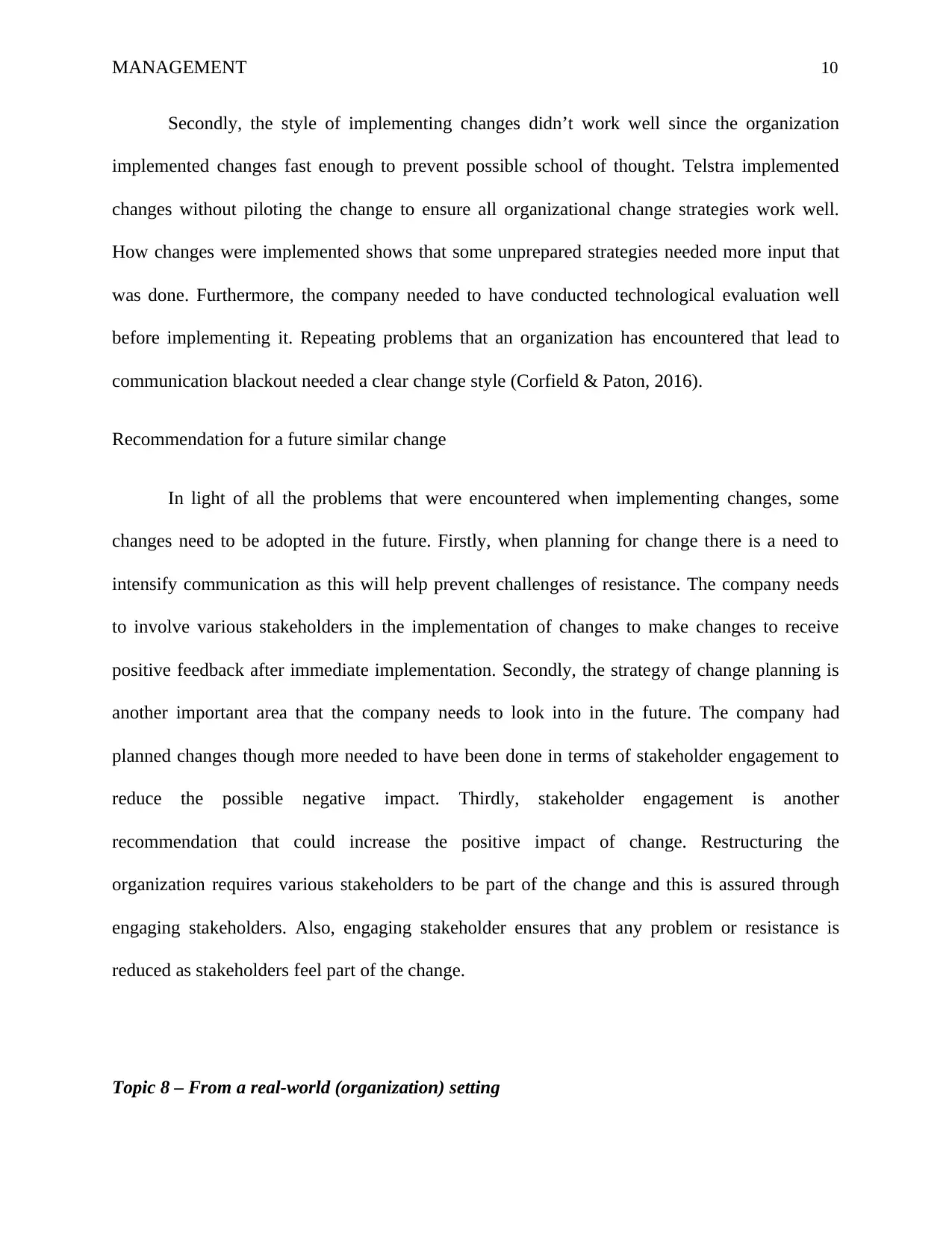
MANAGEMENT 10
Secondly, the style of implementing changes didn’t work well since the organization
implemented changes fast enough to prevent possible school of thought. Telstra implemented
changes without piloting the change to ensure all organizational change strategies work well.
How changes were implemented shows that some unprepared strategies needed more input that
was done. Furthermore, the company needed to have conducted technological evaluation well
before implementing it. Repeating problems that an organization has encountered that lead to
communication blackout needed a clear change style (Corfield & Paton, 2016).
Recommendation for a future similar change
In light of all the problems that were encountered when implementing changes, some
changes need to be adopted in the future. Firstly, when planning for change there is a need to
intensify communication as this will help prevent challenges of resistance. The company needs
to involve various stakeholders in the implementation of changes to make changes to receive
positive feedback after immediate implementation. Secondly, the strategy of change planning is
another important area that the company needs to look into in the future. The company had
planned changes though more needed to have been done in terms of stakeholder engagement to
reduce the possible negative impact. Thirdly, stakeholder engagement is another
recommendation that could increase the positive impact of change. Restructuring the
organization requires various stakeholders to be part of the change and this is assured through
engaging stakeholders. Also, engaging stakeholder ensures that any problem or resistance is
reduced as stakeholders feel part of the change.
Topic 8 – From a real-world (organization) setting
Secondly, the style of implementing changes didn’t work well since the organization
implemented changes fast enough to prevent possible school of thought. Telstra implemented
changes without piloting the change to ensure all organizational change strategies work well.
How changes were implemented shows that some unprepared strategies needed more input that
was done. Furthermore, the company needed to have conducted technological evaluation well
before implementing it. Repeating problems that an organization has encountered that lead to
communication blackout needed a clear change style (Corfield & Paton, 2016).
Recommendation for a future similar change
In light of all the problems that were encountered when implementing changes, some
changes need to be adopted in the future. Firstly, when planning for change there is a need to
intensify communication as this will help prevent challenges of resistance. The company needs
to involve various stakeholders in the implementation of changes to make changes to receive
positive feedback after immediate implementation. Secondly, the strategy of change planning is
another important area that the company needs to look into in the future. The company had
planned changes though more needed to have been done in terms of stakeholder engagement to
reduce the possible negative impact. Thirdly, stakeholder engagement is another
recommendation that could increase the positive impact of change. Restructuring the
organization requires various stakeholders to be part of the change and this is assured through
engaging stakeholders. Also, engaging stakeholder ensures that any problem or resistance is
reduced as stakeholders feel part of the change.
Topic 8 – From a real-world (organization) setting
Paraphrase This Document
Need a fresh take? Get an instant paraphrase of this document with our AI Paraphraser
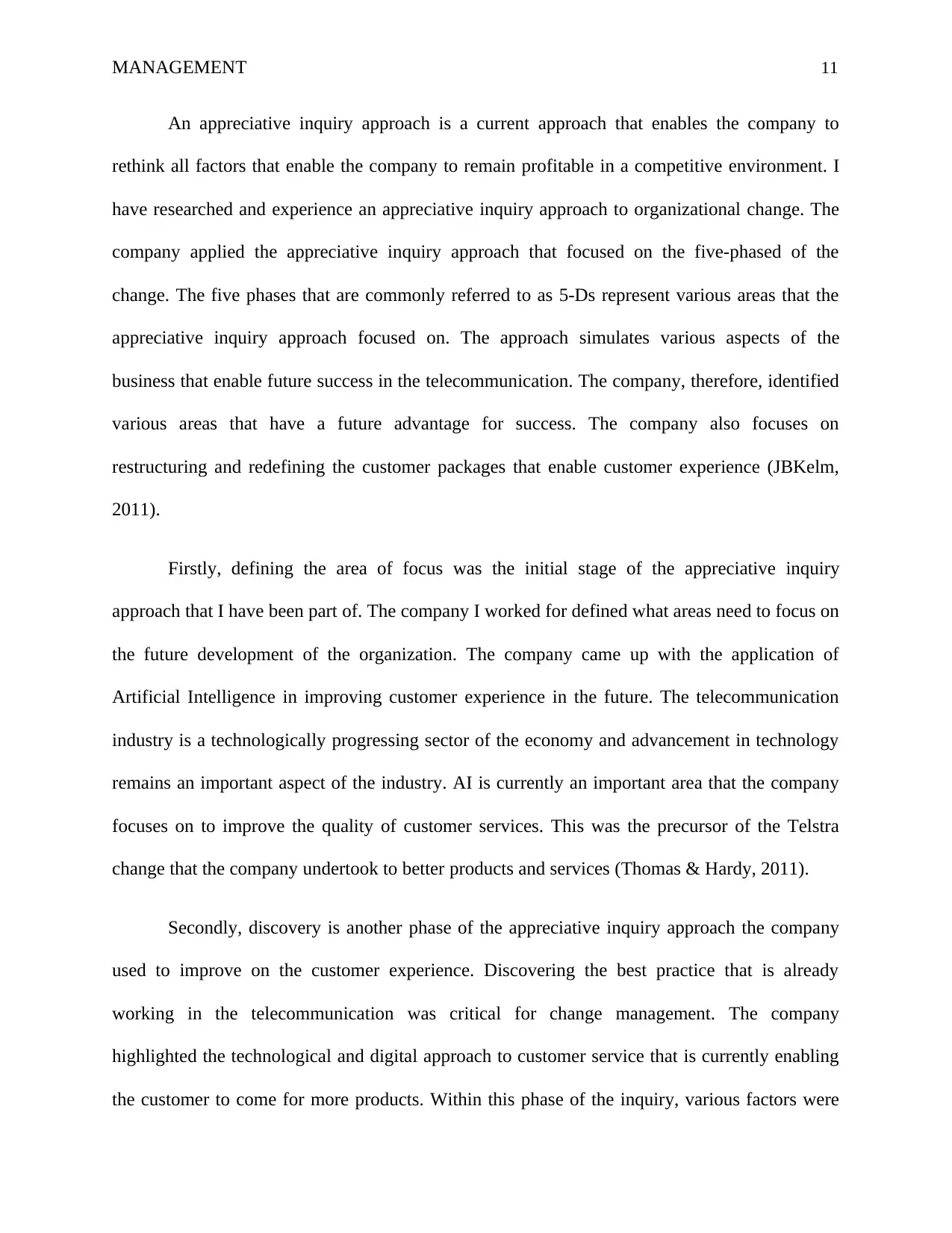
MANAGEMENT 11
An appreciative inquiry approach is a current approach that enables the company to
rethink all factors that enable the company to remain profitable in a competitive environment. I
have researched and experience an appreciative inquiry approach to organizational change. The
company applied the appreciative inquiry approach that focused on the five-phased of the
change. The five phases that are commonly referred to as 5-Ds represent various areas that the
appreciative inquiry approach focused on. The approach simulates various aspects of the
business that enable future success in the telecommunication. The company, therefore, identified
various areas that have a future advantage for success. The company also focuses on
restructuring and redefining the customer packages that enable customer experience (JBKelm,
2011).
Firstly, defining the area of focus was the initial stage of the appreciative inquiry
approach that I have been part of. The company I worked for defined what areas need to focus on
the future development of the organization. The company came up with the application of
Artificial Intelligence in improving customer experience in the future. The telecommunication
industry is a technologically progressing sector of the economy and advancement in technology
remains an important aspect of the industry. AI is currently an important area that the company
focuses on to improve the quality of customer services. This was the precursor of the Telstra
change that the company undertook to better products and services (Thomas & Hardy, 2011).
Secondly, discovery is another phase of the appreciative inquiry approach the company
used to improve on the customer experience. Discovering the best practice that is already
working in the telecommunication was critical for change management. The company
highlighted the technological and digital approach to customer service that is currently enabling
the customer to come for more products. Within this phase of the inquiry, various factors were
An appreciative inquiry approach is a current approach that enables the company to
rethink all factors that enable the company to remain profitable in a competitive environment. I
have researched and experience an appreciative inquiry approach to organizational change. The
company applied the appreciative inquiry approach that focused on the five-phased of the
change. The five phases that are commonly referred to as 5-Ds represent various areas that the
appreciative inquiry approach focused on. The approach simulates various aspects of the
business that enable future success in the telecommunication. The company, therefore, identified
various areas that have a future advantage for success. The company also focuses on
restructuring and redefining the customer packages that enable customer experience (JBKelm,
2011).
Firstly, defining the area of focus was the initial stage of the appreciative inquiry
approach that I have been part of. The company I worked for defined what areas need to focus on
the future development of the organization. The company came up with the application of
Artificial Intelligence in improving customer experience in the future. The telecommunication
industry is a technologically progressing sector of the economy and advancement in technology
remains an important aspect of the industry. AI is currently an important area that the company
focuses on to improve the quality of customer services. This was the precursor of the Telstra
change that the company undertook to better products and services (Thomas & Hardy, 2011).
Secondly, discovery is another phase of the appreciative inquiry approach the company
used to improve on the customer experience. Discovering the best practice that is already
working in the telecommunication was critical for change management. The company
highlighted the technological and digital approach to customer service that is currently enabling
the customer to come for more products. Within this phase of the inquiry, various factors were
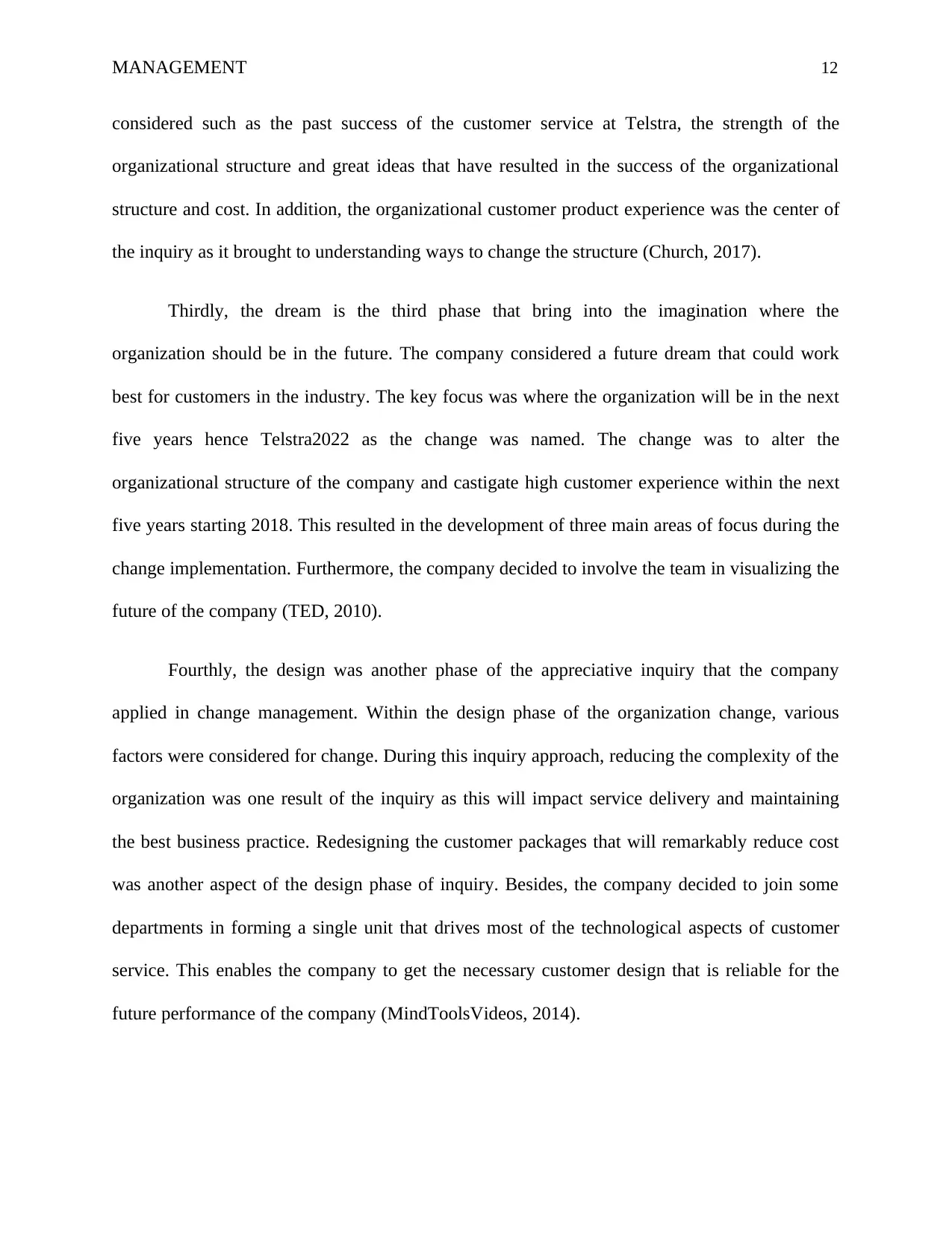
MANAGEMENT 12
considered such as the past success of the customer service at Telstra, the strength of the
organizational structure and great ideas that have resulted in the success of the organizational
structure and cost. In addition, the organizational customer product experience was the center of
the inquiry as it brought to understanding ways to change the structure (Church, 2017).
Thirdly, the dream is the third phase that bring into the imagination where the
organization should be in the future. The company considered a future dream that could work
best for customers in the industry. The key focus was where the organization will be in the next
five years hence Telstra2022 as the change was named. The change was to alter the
organizational structure of the company and castigate high customer experience within the next
five years starting 2018. This resulted in the development of three main areas of focus during the
change implementation. Furthermore, the company decided to involve the team in visualizing the
future of the company (TED, 2010).
Fourthly, the design was another phase of the appreciative inquiry that the company
applied in change management. Within the design phase of the organization change, various
factors were considered for change. During this inquiry approach, reducing the complexity of the
organization was one result of the inquiry as this will impact service delivery and maintaining
the best business practice. Redesigning the customer packages that will remarkably reduce cost
was another aspect of the design phase of inquiry. Besides, the company decided to join some
departments in forming a single unit that drives most of the technological aspects of customer
service. This enables the company to get the necessary customer design that is reliable for the
future performance of the company (MindToolsVideos, 2014).
considered such as the past success of the customer service at Telstra, the strength of the
organizational structure and great ideas that have resulted in the success of the organizational
structure and cost. In addition, the organizational customer product experience was the center of
the inquiry as it brought to understanding ways to change the structure (Church, 2017).
Thirdly, the dream is the third phase that bring into the imagination where the
organization should be in the future. The company considered a future dream that could work
best for customers in the industry. The key focus was where the organization will be in the next
five years hence Telstra2022 as the change was named. The change was to alter the
organizational structure of the company and castigate high customer experience within the next
five years starting 2018. This resulted in the development of three main areas of focus during the
change implementation. Furthermore, the company decided to involve the team in visualizing the
future of the company (TED, 2010).
Fourthly, the design was another phase of the appreciative inquiry that the company
applied in change management. Within the design phase of the organization change, various
factors were considered for change. During this inquiry approach, reducing the complexity of the
organization was one result of the inquiry as this will impact service delivery and maintaining
the best business practice. Redesigning the customer packages that will remarkably reduce cost
was another aspect of the design phase of inquiry. Besides, the company decided to join some
departments in forming a single unit that drives most of the technological aspects of customer
service. This enables the company to get the necessary customer design that is reliable for the
future performance of the company (MindToolsVideos, 2014).
⊘ This is a preview!⊘
Do you want full access?
Subscribe today to unlock all pages.

Trusted by 1+ million students worldwide
1 out of 19
Related Documents
Your All-in-One AI-Powered Toolkit for Academic Success.
+13062052269
info@desklib.com
Available 24*7 on WhatsApp / Email
![[object Object]](/_next/static/media/star-bottom.7253800d.svg)
Unlock your academic potential
Copyright © 2020–2025 A2Z Services. All Rights Reserved. Developed and managed by ZUCOL.





